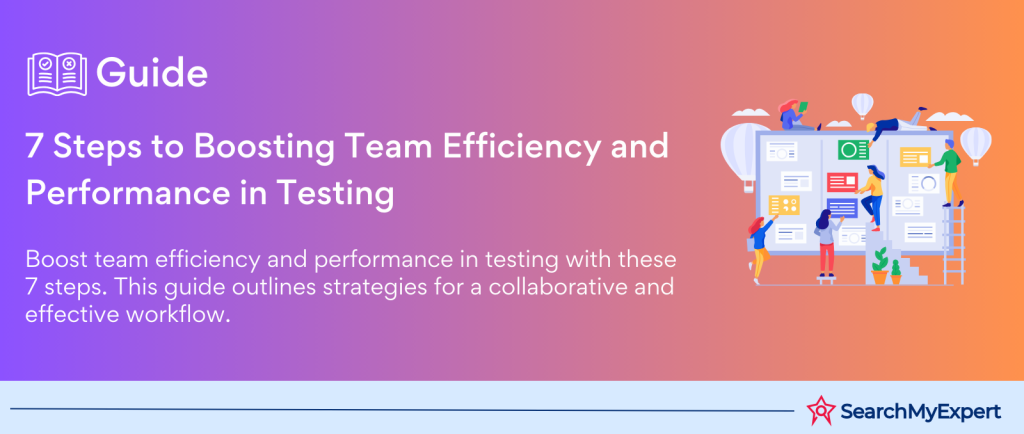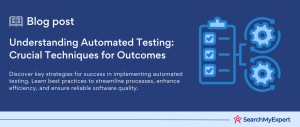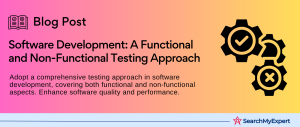Role of Testing Teams and Their Impact on Project Outcomes
Testing teams play a critical role in ensuring the quality and reliability of products and services. Their primary function is to identify bugs, defects, and inconsistencies in software or systems before these issues can affect the end user. By doing so, testing teams contribute significantly to the project outcomes in several ways:
- Quality Assurance:
They ensure that the product meets the required standards and specifications. This leads to increased customer satisfaction and loyalty, as users receive a product that functions as expected. - Risk Mitigation:
Early detection of issues helps in mitigating risks associated with product failure, which can have legal, financial, and reputational implications. - Cost Efficiency: Identifying and fixing bugs in the early stages of development is generally less costly than making corrections after the product has been deployed.
- Enhanced Productivity:
By streamlining the development process and reducing the time spent on revisions, testing teams enable the project to move forward more efficiently. - Feedback Loop:
Testing teams provide valuable feedback to the development team, contributing to the improvement of the product and the development process.
Key Principles for Effective Team Management
Effective team management is vital for the success of testing teams, as their tasks are highly collaborative and require constant communication. Some key principles include:
- Communication:
Clear, transparent, and frequent communication is essential to avoid misunderstandings and ensure that everyone is aligned with the team’s objectives and deadlines. - Collaboration: Encourage a culture of collaboration where team members feel comfortable sharing ideas and constructive criticism. This can lead to innovative solutions and a more cohesive team environment.
- Trust:
Building trust within the team is crucial for a productive work environment. Trust fosters open communication and encourages team members to take initiative and responsibility for their work. - Inclusivity: An inclusive environment where all team members feel valued and respected enhances team performance and creativity.
- Adaptability: Being flexible and open to change is important in a fast-paced development environment. Teams should be prepared to adjust their strategies and processes in response to new information or challenges.
Importance of Setting Clear Goals, Expectations, and Metrics for Success
For testing teams, clearly defined goals, expectations, and metrics are fundamental to achieving success. These elements provide a roadmap and benchmarks that guide the team’s efforts and allow for the evaluation of performance.
- Clear Goals:
Setting specific, measurable, achievable, relevant, and time-bound (SMART) goals gives the team a clear sense of direction and purpose. It helps in prioritizing tasks and focusing efforts on what matters most. - Defined Expectations:
Clearly articulated expectations ensure that each team member understands their roles, responsibilities, and the standards to which their work should conform. This clarity helps in maintaining quality and consistency in the team’s output. - Metrics for Success:
Establishing key performance indicators (KPIs) and metrics allows the team to measure their progress and effectiveness. These metrics can include the number of bugs identified and resolved, the time taken to detect and fix issues, and the improvement in product quality over time. Metrics provide objective criteria for evaluating the team’s performance and the impact of their work on the project outcomes.
Identifying Essential Skillsets and Qualities for Testing Team Members
To build a competent and effective testing team, it’s crucial to identify the right mix of skillsets and personal qualities. Essential attributes include:
- Technical Skills:
Proficiency in various testing methodologies (e.g., manual, automated, performance testing), understanding of programming languages relevant to the project, and familiarity with testing tools and environments. - Analytical Skills: The ability to critically analyze requirements, design test cases, and meticulously identify potential issues are fundamental for effective testing.
- Attention to Detail:
Precision is key in testing; missing minor details can lead to undetected bugs. A keen eye for detail is, therefore, essential. - Problem-Solving Abilities: The capacity to think creatively and logically to solve complex problems and find workarounds for various challenges.
- Communication Skills:
Clear and concise communication is necessary for documenting bugs, explaining findings, and collaborating with development teams. - Adaptability: Flexibility to quickly learn new tools and technologies, and adapt to changing project requirements and timelines.
- Teamwork and Collaboration:
Being a team player, willing to share knowledge, support colleagues, and work cooperatively towards common goals. - Curiosity and Continuous Learning:
A genuine interest in technology, a passion for quality, and a commitment to continuous improvement and learning.
Designing an Efficient Recruitment Process
An effective recruitment process ensures that you hire candidates with both the technical skills and the cultural fit necessary for your team’s success. Key steps include:
- Job Description:
Clearly define the role, responsibilities, required skills, and desired qualities to attract suitable candidates. - Sourcing Candidates:
Utilize various channels such as job boards, social media, professional networks, and employee referrals to source a diverse candidate pool. - Screening: Initial resume screening followed by phone or video interviews to assess candidates’ communication skills and preliminary fit.
- Technical Evaluation:
Conduct technical assessments through coding challenges, practical tests, or case studies relevant to your testing environment. This evaluates the candidate’s technical proficiency and problem-solving approach. - Cultural Fit Assessment: Include interviews or activities designed to assess how well the candidate aligns with the team and company culture, values, and working style. This can involve discussions around past team experiences, collaboration scenarios, and personal motivation.
- Team Interaction:
Facilitate meetings between the candidate and potential future team members. This step can provide insight into how well the candidate will integrate with the team and can offer team members a voice in the selection process. - Reference Checks: Perform reference checks to validate the candidate’s past work performance, teamwork capabilities, and other relevant attributes.
Developing a Robust Onboarding Program
A well-structured onboarding program is essential for quickly and effectively integrating new members into the team. Key components of an effective onboarding program include:
- Welcome and Introduction:
Start with a warm welcome and introduce new hires to the team and other key personnel. Provide an overview of the company culture, mission, and values. - Comprehensive Training:
Offer detailed training sessions covering the tools, technologies, and processes your team uses. This should include hands-on sessions for software and tools specific to your testing procedures. - Project Overviews:
Give new members an overview of ongoing and upcoming projects. This helps them understand their role within the team and how they contribute to the project’s goals. - Mentorship Program:
Pair new hires with experienced team members who can guide them through their initial period, answer questions, and provide support as they acclimate to their new role. - Regular Check-ins: Schedule regular one-on-one meetings to discuss progress, address any concerns, and provide feedback. This helps in adjusting the onboarding process to better suit the new hire’s needs and accelerates their integration into the team.
- Feedback Loop:
Encourage new members to provide feedback on the onboarding process. This feedback can be invaluable for refining and improving the program for future hires.
Importance of Clear Requirements, Test Plans, and Test Case Management
The foundation of any successful testing process is built on clear requirements, comprehensive test plans, and effective test case management. Here’s why they are important:
- Clear Requirements:
Understanding the project’s requirements is crucial for defining the scope of testing. Clear, detailed requirements help in identifying what needs to be tested, thus ensuring that the testing team focuses on the right areas and that no critical functionality is overlooked. - Test Plans:
A test plan outlines the testing strategy, objectives, schedule, resources, and deliverables. It serves as a roadmap for the testing team, providing a structured approach to testing and ensuring that all aspects of the application are covered. - Test Case Management:
Effective test case management involves organizing, managing, and maintaining test cases in a way that they can be reused, tracked, and updated efficiently. It helps in ensuring thorough testing coverage and facilitates reporting and analysis of test results.
Techniques for Accurate Test Effort Estimation and Workload Distribution
Accurate estimation of testing efforts and proper workload distribution are critical for meeting project timelines and ensuring a high-quality outcome. Here are techniques to achieve this:
- Historical Analysis:
Use data and insights from previous projects to estimate the effort required for testing similar features or functionalities. - Expert Judgment:
Leverage the experience and knowledge of senior team members to estimate the testing effort based on their understanding of the project complexity and requirements. - Three-Point Estimation:
This technique involves estimating the best-case, worst-case, and most likely scenarios to calculate an average estimate, offering a more realistic view of the required effort. - Work Breakdown Structure (WBS):
Break down the project into smaller, manageable components or tasks. Estimate the effort for each task and sum up to get the total effort required for testing. - Workload Distribution:
Once the estimation is done, distribute the workload among team members based on their expertise, experience, and availability. Consider using tools for resource allocation and tracking to maintain balance and prevent burnout.
Agile Testing Methodologies and Tools for Flexible Planning and Adaptation
Agile testing methodologies emphasize flexibility, continuous feedback, and iterative development, which aligns well with dynamic project requirements and fast-paced development cycles. Here’s how agile testing methodologies and tools support flexible planning and adaptation:
- Iterative Development:
In agile, testing is integrated into the development process, allowing for continuous testing and immediate feedback. This helps in identifying and addressing issues early, reducing the risk of major defects. - User Stories and Acceptance Criteria: Testing based on user stories and their acceptance criteria ensures that the functionality meets the user’s needs and expectations. It allows for focused and effective testing.
- Continuous Integration and Continuous Deployment (CI/CD):
Automated testing tools integrated into CI/CD pipelines enable quick execution of tests and immediate identification of issues as changes are made to the codebase. - Collaboration Tools:
Agile projects benefit from tools that enhance communication and collaboration, such as Jira for tracking user stories and bugs, Confluence for documentation, and Slack for team communication. - Adaptation to Change: Agile testing is about embracing change. Regular retrospectives and planning sessions allow teams to reflect on what worked well and what didn’t, and to adjust their testing strategy accordingly.
Prioritization Strategies Based on Risk, Impact, and Coverage Requirements
Effective prioritization of test cases is crucial for optimizing the testing process, especially when time and resources are limited. Here are strategies to prioritize testing activities:
- Risk-Based Prioritization: Identify the areas of the application that carry the highest risk of failure and prioritize testing these areas first. Factors to consider include complexity, historical defect trends, and the criticality of the feature to the business.
- Impact Analysis:
Focus on testing functionalities that have the highest impact on the user experience and business objectives. This ensures that the most crucial aspects of the application are reliable and meet user expectations. - Coverage Requirements:
Aim for a balanced test coverage that encompasses different aspects of the application, including functional, performance, security, and usability testing. Prioritize tests that cover core functionalities and critical paths over less critical areas.
Automation Tools and Frameworks for Efficient Test Execution and Regression Testing
Automation plays a key role in enhancing the efficiency and effectiveness of test execution, particularly for regression testing. Here’s how:
- Selection of Automation Tools:
Choose automation tools that align with your project’s technology stack and testing needs. Popular tools include Selenium for web applications, Appium for mobile apps, and JUnit or TestNG for unit testing. - Utilizing Frameworks: Implement frameworks that provide a structured approach to test automation, such as the Page Object Model (POM) for enhancing maintainability, or data-driven frameworks for facilitating testing with various data sets.
- Continuous Integration (CI):
Integrate automation tests into CI pipelines to ensure that tests are run automatically with every code commit, enabling early detection of defects. - Regression Testing:
Use automation to perform regression testing efficiently. Automated regression tests can be run frequently and consistently, ensuring that new changes have not adversely affected existing functionalities.
Importance of Defect Tracking, Reporting, and Communication with Stakeholders
Defect tracking and effective communication are pivotal for the testing process and overall project success. Here’s why:
- Defect Tracking Systems:
Utilize defect tracking systems like Jira, Bugzilla, or Trello to log, monitor, and manage defects. These systems help in organizing the defects, prioritizing them based on severity and impact, and tracking their resolution status. - Reporting:
Generate detailed and clear reports that highlight key issues, their severity, and the impact on the project. Reports should be tailored to the audience, providing high-level summaries for stakeholders and detailed analyses for the development team. - Communication with Stakeholders: Maintain regular communication with stakeholders, including developers, project managers, and clients, about the testing progress, major findings, and potential risks. Effective communication ensures transparency, facilitates decision-making, and helps manage expectations.
Leadership Styles and Strategies for Fostering Motivation and Engagement
Effective leadership is pivotal in fostering a motivated and engaged testing team. Different leadership styles can be employed depending on the team’s dynamics, project requirements, and organizational culture. Here are some strategies to consider:
- Servant Leadership:
Focuses on the growth and well-being of team members. Leaders who adopt this style prioritize the needs of their team, helping to remove obstacles, providing support, and empowering members to perform at their best. - Transformational Leadership:
Inspires team members to exceed expectations by focusing on innovation, creativity, and change. Leaders encourage members to take ownership of their roles, challenge the status quo, and contribute ideas for improvement. - Democratic Leadership: Involves team members in decision-making processes, promoting a sense of ownership and accountability. This style fosters open communication, collaboration, and mutual respect within the team.
Recognizing Individual Contributions and Achievements
Acknowledging individual contributions and achievements is crucial for maintaining high levels of motivation and engagement. Here are ways to recognize and reward team members:
- Formal Recognition Programs: Implement award programs that recognize outstanding contributions, such as “Employee of the Month” or “Best Innovation in Testing.” These programs can include certificates, trophies, or monetary rewards.
- Informal Recognition:
Simple gestures like thanking team members in team meetings, sending personalized appreciation emails, or giving small tokens of appreciation can significantly boost morale. - Peer Recognition:
Encourage a culture where team members appreciate and recognize each other’s contributions. Peer-to-peer recognition programs can facilitate this, enhancing team cohesion and motivation.
Providing Opportunities for Professional Development and Learning
Continual learning and professional development are key to keeping the team motivated and ensuring they have the skills needed to meet evolving project requirements. Here are strategies to support team members’ growth:
- Training and Workshops:
Allocate budget and time for team members to attend relevant training, workshops, and conferences. This not only enhances their skills but also keeps them updated with the latest trends and technologies. - Mentorship and Coaching:
Establish a mentorship program where experienced team members mentor juniors. This can include one-on-one coaching sessions, shadowing opportunities, and regular feedback. - Career Path Planning:
Work with team members to develop personalized career path plans. Discuss their aspirations, identify needed skills and experiences, and set clear goals and milestones. - Cross-functional Collaboration:
Provide opportunities for team members to work on cross-functional projects or with different teams. This exposure can broaden their skill set and understanding of the business.
Defining Key Performance Indicators (KPIs) for Testing Team Effectiveness
To effectively measure the performance of a testing team and ensure continuous improvement, it’s essential to define clear Key Performance Indicators (KPIs). These metrics should provide insight into the efficiency, quality, and impact of the testing efforts. Here are some KPIs to consider:
- Test Coverage: Measures the extent to which the application is tested. High test coverage indicates a lower risk of undetected defects.
- Defect Detection Efficiency:
The ratio of defects found during testing to the total defects found after release. This indicates the effectiveness of the testing process in catching bugs before deployment. - Defect Resolution Time:
Tracks the average time taken to resolve a defect once it’s reported. Faster resolution times are indicative of an efficient development and testing process. - Test Execution Time:
The time required to complete the testing cycle. Optimizing this metric can lead to faster release cycles. - Automated Test Percentage: The proportion of tests that are automated versus manually executed. Higher automation rates can improve testing efficiency and consistency.
- Pass/Fail Rate of Test Cases: The percentage of tests that pass versus those that fail. This can help identify areas of the application that may require more attention or development effort.
Encouraging Regular Process Improvement Initiatives
Continuous improvement is key to maintaining an efficient and effective testing process. Encourage a culture of ongoing improvement through the following strategies:
- Data-Driven Insights: Utilize the data from KPIs to identify areas for improvement. Analyze trends over time to understand the impact of changes implemented.
- Innovation Sessions:
Regularly schedule sessions dedicated to brainstorming improvements in tools, processes, and methodologies. Encourage team members to bring forward ideas and suggestions. - Pilot Programs:
Implement pilot programs to test new tools, processes, or methodologies on a small scale before rolling them out team-wide. This can help assess their effectiveness and make necessary adjustments.
Conducting Retrospective Meetings
Retrospective meetings are an essential component of the agile framework but can be beneficial in any project management methodology. Here’s how to conduct effective retrospectives:
- Schedule Regularly: Hold retrospectives at the end of each major milestone or project phase to review what went well, what didn’t, and why.
- Encourage Open Communication:
Create a safe and open environment where team members feel comfortable sharing their thoughts, experiences, and suggestions for improvement. - Focus on Actionable Insights: Identify key takeaways and actionable insights during the meeting. Assign responsibility for implementing these changes to ensure they are enacted.
- Follow Up on Actions:
In subsequent meetings, review the actions taken since the last retrospective to assess their impact and effectiveness.
Conclusion
Building and maintaining a high-performing testing team is crucial for the success of any project. It requires a strategic approach, starting from defining clear roles and responsibilities, recruiting and onboarding the right talent, to fostering an environment of teamwork and collaboration. Leadership plays a pivotal role in motivating the team, recognizing their efforts, and providing opportunities for professional growth. To ensure the team’s efforts are aligned with project goals, it’s essential to define key performance indicators, encourage a culture of continuous improvement, and regularly review processes and outcomes through retrospective meetings.
Experience comprehensive testing solutions with our Software Testing Service Company.
Table of Contents
Toggle






